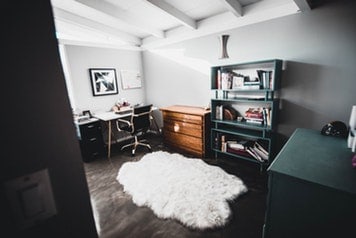As someone who works from home, I was faced with the same question and took the advice from work-at-home professionals and discovered what really works when determining where to put a home office desk.
So, where should you put your home office desk? Place your desk is an area that doesn’t have much traffic, is well ventilated, and has good light. Natural light is preferable. It should be large enough for your needs, including access to supplies and equipment you use often, and it should be free from distractions. Create a place where you can concentrate by tidying up clutter, and by adding your own personal touches to make it feel comfortable.
For people setting up their home office for the first time, they may make hasty decisions only to find out they have spent some money in painting and redecorating only to realize the place they placed their desk eventually doesn’t work out. To prevent that from happening to you, let us consider the different elements in selecting a place for your desk.
Benefits of Having Plants In Your Home Office
Select a dedicated area that puts you into work mode
Choosing a permanent place is important because it triggers your body to go into work mode as you would if you were entering your office. Since you are setting up a workplace at home, this notion should be most significant. The place you choose should get you into the work mode, and keep you in that working mode.
Your desk should not be somewhere that turns into something else at the end of the day such as video-game area. What you are trying to do is create a mindset. You should only be thinking of work when you go to your desk and that would be difficult if it is a multipurpose area that is used for entertainment or relaxation.
The body senses patterns amazingly well. When you go up a staircase, you only have to walk up a few steps and your body knows how high you need to step each time without you ever thinking about it. The same thing happens in your workplace. If you use a single place for work, your body gets the pattern and soon enough your body gets “tricked” into going into work mode just by going to your desk. This is why it is imperative that your desk is in a permanent area. If there is anything to get out of this article, it is this.
How to Design a Feng Shui Home Office
While your desk should be in a fixed section of the house, you don’t have to put your desk in a separate room. For as long as your workspace is permanent, it will do. It can be part of a larger room where you can see yourself working without getting distracted by the rest of the family. It can be in the corner of the living room, or at the end of a hallway.
If you are working for an organization, they may have security concerns, and a dedicated place is a safe place to work without the rest of the family seeing sensitive information.

Organize supplies and equipment so they are easily accessible
In selecting a place to put your desk, the workflow is important too. Unnecessarily moving around too much can kill productivity. Time-motion specialists like to recommend having the most used supplies and equipment nearest to you. This will prevent you from having to get out of your chair every time, which is most likely to disrupt your workflow and eat up your time. So if you use the phone often, put it within arm’s reach. If you print often, place the printer nearby and have your supply of paper in a drawer under it.
You can keep the less used things further away, and I find that having a chair with rollers makes it easy to access those without standing up.
Do the opposite too. Keep in a storage bin the things you seldom or never use at all.
Are standing desks actually bad for you?
Select a place that is free from distractions
Distraction is the archenemy of professionals who work at home. Since there is no boss who can peer into your “office,” work-at-home professionals can do anything they want. The temptation to turn on Netflix or chat with the spouse can be too much sometimes that we turn our focus away from work. So here are some tips that may help:
- Select a place where it isn’t busy. Choose a place where there isn’t a lot of activity or noise. The kitchen is where the family usually gathers, so setting up your desk near there is not a good idea. The front door is another high-traffic area, and it wouldn’t be recommended to have that in your line of sight either.
- Turn your desk and chair away from the door. Since you are no longer in an office, you don’t need to face the door. Keeping your back to the door will turn your eyes away from any movement. This can help you concentrate for longer periods.
- Clear clutter from your desk. Having so many unnecessary things on your desk can be a source of distraction. If your desk is in a larger room, move distracting things away from your field of vision. These can be the likes of video games, the television, and glorious food that relentlessly beckon most of us.
- Keep in drawers or cupboards the supplies you don’t use every day. Stacks of paper and folders can get messy in a short time regardless of how neatly they are stored. For most people, tidiness creates an environment conducive to work.

Keep it professional, but don’t create a prison
While you are trying to create a distraction-free environment, don’t be too zealous as to forget to keep it from getting too stuffy. Remember that you need a well-ventilated area or else the stale environment may keep you from being productive if you can’t concentrate. If you have a fan, turn it on to circulate the air. If it is summer and you need air-conditioning, then that might be something worthwhile to invest
It would be nice to have your desk near a window. That way you can look out into the distance so that you don’t feel too trapped inside the house. Just make sure that the window faces an area that doesn’t have too much activity or it might be a source of distraction.
Let there be light! Be sure to have lots of light whether natural or from bulbs. Light always creates a more cheerful ambiance that produces a positive work mood. Make sure to position your computer monitor away from light glare to cut down on eye strain and headaches.
Make it personal. Add personal touches of color, decorating style, and patterns. Make the home office yours so you will enjoy working on it.
Some questions to ask yourself when determining the best location for a desk
In trying to determine the place for your desk, here are some useful questions to ask:
- How large a desk surface do you need? How large a floor area do you need? This will give you an idea of what areas in the house might be available for your home office.
- What working patterns do you have? Spend a few days noticing how you work at home. What do you spend most of your time on? Where do you spend most of your time? Make that area the most comfortable and accessible. If you do your work mostly around the computer, for example, make that the center of your workspace.
- Do you have coffee often? Maybe you should have a coffee machine nearby.
- Do you constantly refer to books or manuals? If so, it might be a good idea to position your desk beside a bookshelf.
- What different areas at home are possible places to place your desk? Take inventory and assess the area based on making it:
- a permanent work area,
- a place that has the least distraction,
- and a floor area large enough for your requirements.
- Are some items in the room taking too much of your attention from work? Remove them or place them inside drawers or bins.
- Do you work with music? Have a sound system you can access by remote so you don’t have to keep standing up.
How to use a sit-stand desk correctly
A chart to help determine where to set up your desk
Determining where to place your desk might not necessarily be a one-time endeavor. If the current place of your desk isn’t working for you, you can always move it to another place. The disastrous thing is to have spent money
The following chart can be a nice scientific way to figure out where to put your desk.
The first column contains criteria, while the other columns are prospective places to place your desk. Rate each location by row. Give it a 10 if it describes the criteria well, and 0 if it doesn’t describe the criteria at all. (You may add more criteria as you see fit.) Total the columns to see which location has the best fit. In this example, it would seem Location 2 is the best contender for where to put the desk.
| Location 1 Living room (70 ft2) | Location 2 Spare Bedroom (25 ft2) | Location 3 Area by the stairs (10ft2) | |
| Permanent | 10 | 8 | 10 |
| Area needed (7ft2) | 10 | 9 | 7 |
| Low Distraction | 2 | 10 | 3 |
| Light | 10 | 9 | 8 |
| Window View | 10 | 9 | 9 |
| Ventilation | 10 | 9 | 10 |
| Total | 52 | 54 | 47 |
Related questions
How do I choose a desk for my home office? Most important is to consider the size. It should fit in the space where you plan to put it. Also, consider what you will be doing on it. For example, if you will be using the computer most of the time, you don’t need a big desk unlike if you used it also for paperwork or crafts. If you work on a computer a lot, consider having a pull out drawer for the keyboard so your arms will be typing at a downward angle to avoid wrist strain. It is always nice to have a lot of legroom so that you are more comfortable longer. If you are concerned about aesthetics, consider the material and style so that it matches with the materials and style of the place you will put it. If you are female and wear skirts at home, you may want to choose a desk with a “modesty panel” that covers the front of the desk. (Check out what I u
What is the right chair for my desk? Most professionals will advise to not scrimp when getting a chair because it has to be comfortable to work in for long periods. So a chair whose height you can adjust is best so when you sit on it, your legs are parallel to the ground. Select one with a good backrest even if it means having to go a store and trying it out (sometimes online shopping just won’t do.) Make sure you can adjust the tension so you can control how much the backrest inclines when you put your weight on it. Lastly, a swivel chair with wheels helps if you move around a lot like say if you often fetch reference books from a table or supplies from a drawer.
